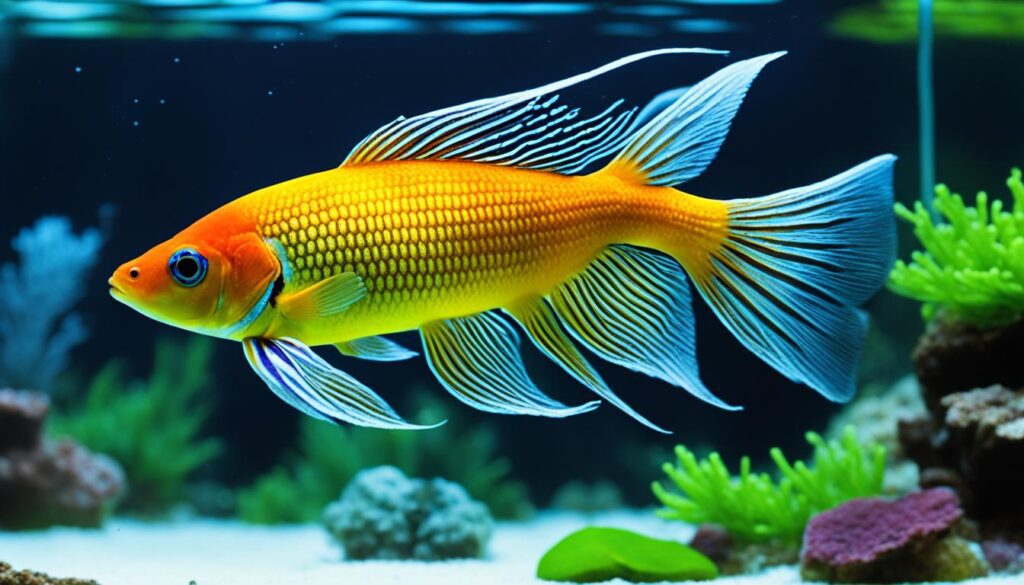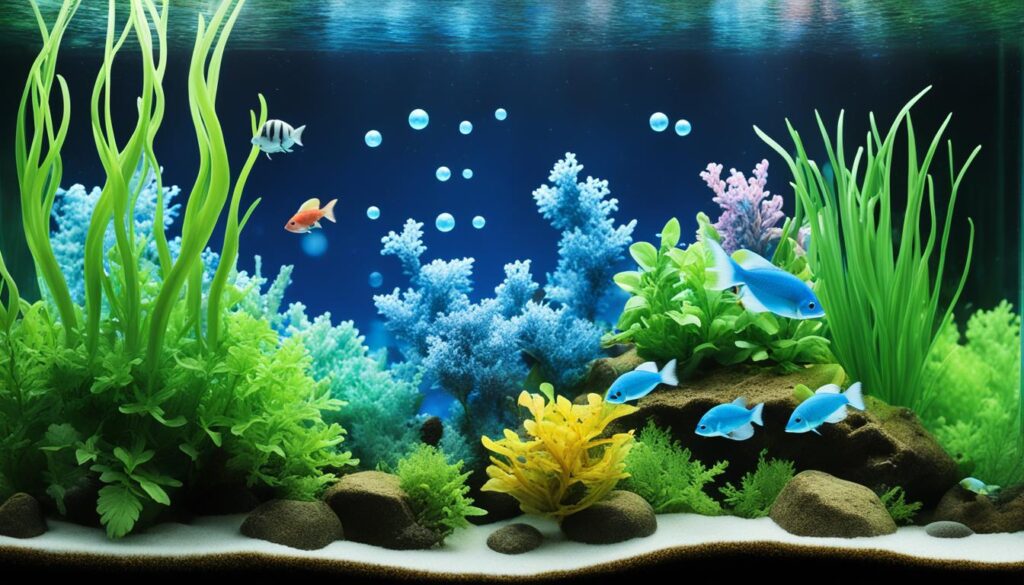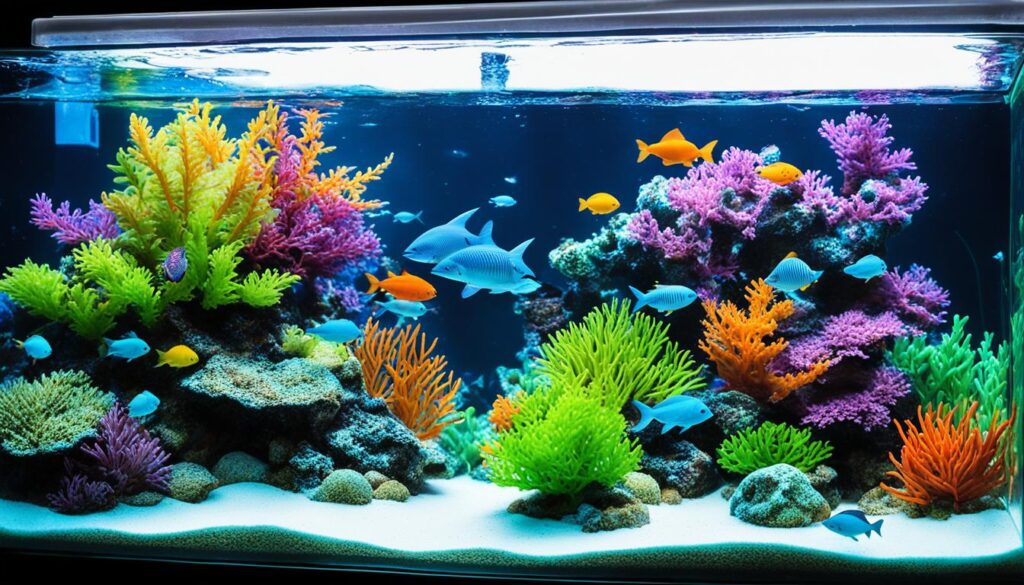Every aquarium lover knows keeping the right dissolved oxygen (DO) balance is key. We often talk about feeding fish and checking pH levels. But, the value of aquarium oxygen levels is also huge. It’s a key part of making a thriving aquatic environment.
I’ve learned from keeping fish that water’s traits can trick you. Even though it looks clear, its reaction with temperature changes everything for the habitat. Since water is thicker than air and fish are good at getting oxygen, a slight temperature shift can greatly affect underwater homes.
In talking about how temperature affects aquariums, it’s vital to know warmer water has less oxygen. This fact is crucial because fish need more oxygen when it gets warmer. So, keeping a balanced temperature is essential. Doing so helps ensure we keep a peaceful, healthy underwater world.
Understanding Dissolved Oxygen (DO) in Aquatic Environments

Dissolved oxygen (DO) plays a key role in the health of aquatic systems. It affects the well-being of fish and the process of decay and renewal in water. If you’re interested in water bodies, knowing about DO is key. It helps keep the environment and economy thriving.
What is Dissolved Oxygen and Its Importance for Aquatic Life
Dissolved oxygen is free oxygen in water. It’s vital for fish, bugs, bacteria, and plants in water. DO levels meet the aquatic life oxygen needs. Things like water warmth, organic matter, and plant growth affect oxygen amounts.
How Oxygen Enters Water: Diffusion and Aeration Explained
Oxygen gets into water by mixing with air or when water moves. This can happen naturally or by using machines. The mixing is changed by how warm or salty the water is and the air pressure. Also, adding air on purpose is important for keeping fish farms healthy.
The Role of Temperature and Aquatic Photosynthesis
Temperature plays a big role in how plants grow in water and make oxygen. When the sun is up, plants make more oxygen. This balance is vital but gets hard when it’s too hot or cold for plants to grow right. So, it’s important to understand this for the health of water life.
To show how dissolved oxygen levels rely on temperature and environment, let’s see some facts:
Condition |
DO Levels Necessary for Fish (ppm) |
Effect on Aquatic Life |
|---|---|---|
Aquaculture Industry |
5-6 |
Optimal for growth and survival |
Temperature Increase/Decrease |
Below 3 becomes stressful |
Stress leading to potential mass die-offs |
Excessive Organic Material |
Varies, but severe depletion possible |
Eutrophic conditions, low oxygen availability |
Photosynthesis Rates |
Increases during daylight |
Supports elevated daytime DO levels |
This info shows the link between temperature, dissolved oxygen, and life in water. Keeping everything in balance is vital. It requires ongoing attention and effort to manage well.
The Scientific Relationship Between Temperature and Dissolved Oxygen

Water temperature and dissolved oxygen (DO) levels share a critical link. As water gets warmer, its ability to hold oxygen drops. This affects the health and survival of fish and other aquatic life.
Exploring the Inverse Relationship
There’s a well-known inverse connection between water’s warmth and its oxygen content. When water heats up, its molecules move faster. This activity makes it hard for oxygen to stay dissolved. In cooler water, more oxygen can dissolve, which is better for aquatic life.
Molecular Behavior at Different Temperatures
At lower temperatures, water molecules move slower. This slow movement helps the water hold more oxygen. This fact is vital for the survival of certain fish species. For example, cooler waters greatly help the Chinese sturgeon survive better during transport.
In studies with young largemouth bass, scientists kept the DO level at 7 mg/L. They tested this at four different temperatures: 20, 15, 10, and 5°C. The tests showed that cold water holds oxygen better. This leads to healthier, more vigorous fish.
The relationship between water temperature and DO is key in aquatic science. Understanding it helps manage ecosystems and conserve species. It ensures the health of our water environments and their inhabitants.
The Impact of Seasonal and Daily Temperature Fluctuations

As seasons change, particularly when it gets warmer, water systems see big shifts in dissolved oxygen levels. These changes can threaten fish and other marine creatures. The rise in summer heat can cause summer oxygen depletion, which is bad for our water habitats.
Summer Heat and Oxygen Levels
Hot summers can bring about drastic seasonal temperature changes. These changes decrease the oxygen in water. This situation is harmful to sea life that needs plenty of oxygen. Warm water does not hold a lot of oxygen. It also makes fish use more oxygen because their body activities speed up. Plus, heat speeds up the breakdown of dead plants and animals, which lowers oxygen even more.
Nighttime Do Dips and Daytime Peaks: A Daily Oxygen Cycle
The daily oxygen cycle greatly affects water environments, too. Oxygen levels go up during daylight from plants making oxygen. But at night, oxygen can fall sharply. This is because plants stop making oxygen, and all living things keep using it. This cycle can be hard on fish and other creatures, especially in small spaces like tanks or overcrowded ponds.
Knowing how temperature and oxygen levels interact is key to keeping water life healthy. We use this understanding to better manage water conditions. This means controlling air added to the water and how many creatures live in it. Such steps are crucial in places with huge changes in temperature throughout the day or year. These changes can stress fish and other animals.
Parameter |
Ideal Range |
Effects of Deviation |
|---|---|---|
Temperature |
10°C – 25°C |
Higher temperatures can decrease oxygen solubility, affecting fish metabolism. |
Dissolved Oxygen |
6-10 ppm |
Levels below 6 ppm can stress aquatic life, leading to health issues or mortalities. |
Nighttime Oxygen Levels |
Above 5 ppm |
Drops below 5 ppm can hinder fish recovery from daily stress, impacting overall health. |
To keep our water creatures safe, we must always watch and manage dissolved oxygen fluctuations due to temperature shifts. Being ahead of these changes helps aquatic ecosystems stay strong. They can then withstand the effects of seasonal temperature changes and daily oxygen cycle shifts.
Consequences of Low Oxygen Levels in Aquariums
As an aquarist, I’ve seen how low oxygen, or hypoxia, can harm aquarium life. It’s key to keep oxygen at safe levels for the fish. Experts say that 8.3 ppm is the safe oxygen level for freshwater fish. This makes sure our aquatic friends stay healthy and avoid death.
Hypoxia: Recognizing the Threshold
Knowing when oxygen gets too low is as important as not overstocking your tank. Too many fish can lead to not enough oxygen, which is a big problem. Also, warmer water holds less oxygen. So, keep an eye on temperature, especially when it gets hot.
The Effect on Aquatic Plant and Animal Life
Ignoring DO levels affects fish and plants badly. Fish struggle for air and move their gills fast when oxygen drops. Water should be between 65 to 70 degrees Fahrenheit for enough oxygen. In emergencies, stirring water or adding cooler water helps. Good aeration and care keep the aquarium healthy.








